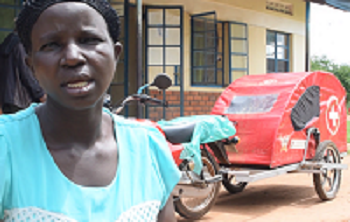

Jane Amulen, Florence Asekenye and Jane Atenge share a couple of things. The trio stays in Ajepet parish near the shores of Lake Kyoga, Gogonyo sub-county in the eastern Uganda district of Pallisa.
But that’s not all, they are all mothers and their latest uniting factor is that they are beneficiaries of a village ambulance initiative, supported by Makerere University School of Public Health in partnership with Pulse, with an innovation grant from the Resilient Africa Network.
Although Florence Asekenye did not have a good outcome from her pregnancy, she is happy she was able to reach hospital to receive skilled care. “It all started with bleeding due to a threatening abortion. We called the ambulance rider who picked us from home to Pallisa hospital, where the fetus came out shortly after arrival. The same transporter helped me until he handed me over to the health workers. That is the advantage I see with the ambulance.”
Similarly, for Jane Amulen, the ambulance came in handy when it was time to deliver. “When we got to the facility, there were no gloves, medicines, so Oumo [ambulance rider] ran very fast with the ambulance to get what the health workers asked for and they helped me. I paid him only 2000 shillings for fuel,” Ms Amulen recalls.
Jane Ateng produced her baby onboard the ambulance on the way to the health facility but expressed gratitude for the initiative.
Gogonyo Sub-County Chief Mr Muhamood Kisu Atta says prior to the arrival of the two ambulances, transport was a burden to the community.
“We are using those ambulances to take our children and mothers to health facilities to access treatment services,” says Mr Atta. “This has simplified life. The mothers are not being charged a lot of money. All they do is to pay for the fuel and they are picked from her home to the health facility or taken to Pallisa Hospital in case of referral, which is 22 kilometres away.”
According to Makerere University School of Public Health’s Dr Elizabeth Ekirapa-Kiracho, previous work in this community showed that lack of adequate transport for patients led to delay in seeking care, failure to seek care and subsequently poor health outcomes.
“With these low-cost community-based ambulances, we hope that these challenges will be minimized,” Dr Ekirapa-Kiracho said during a recent visit to Gogonyo.
Beneficiary Jane Ateng concurred with Dr Ekirapa-Kiracho saying “we can now easily reach our health centre for delivery because now the ambulance is very close, and we can get it in a very short time. Even if they tell us to pay some small money it is okay because we need to fuel the ambulance, it cannot move without fuel.”
With their potential to radically transform transport for health not so much exploited, this pilot seeks to expand the demand for these low-cost motorcycle ambulances through an innovative model that stimulates demand for the ambulances and enhances local ownership and maintenance of the ambulances.
In addition to transporting patients, the motorbike ambulances are also meant to ease the movement of health workers for emergencies or outreaches, vaccines and drugs. It is expected that proceeds from the ambulances will be used to pay the riders, maintain the ambulances and save money for purchasing a new ambulance eventually.
